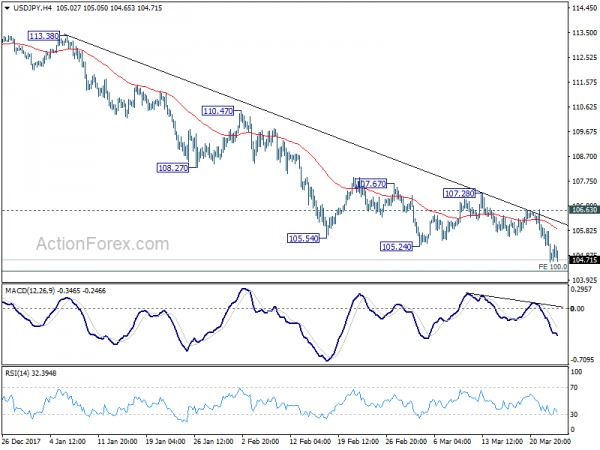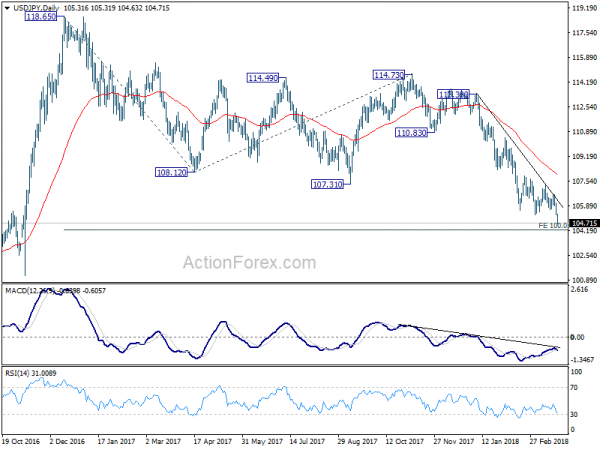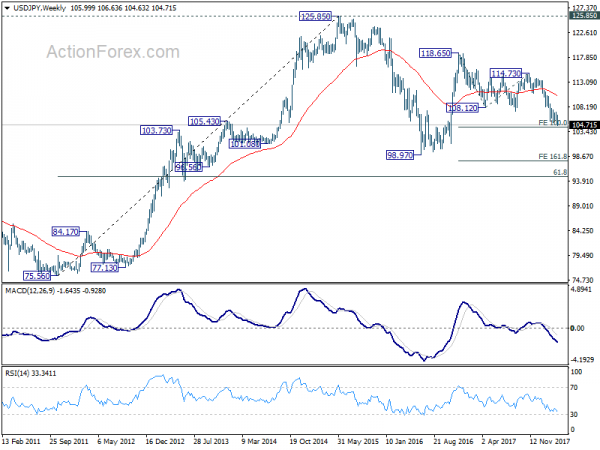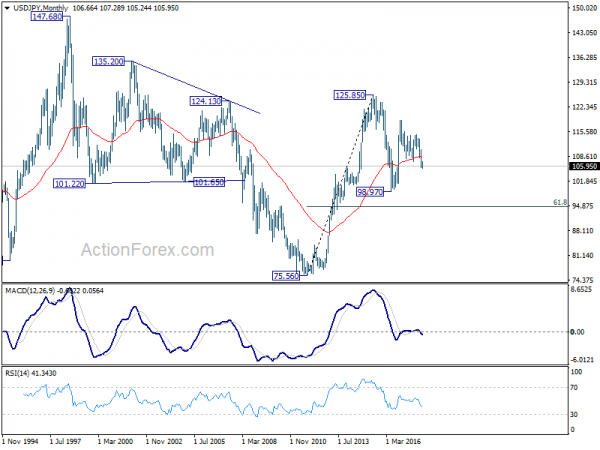Global stock markets suffered steep selloff last week as US President Donald Trump has finally declare the start of trade war with China. Dollar was under broad based pressure with the development, but it was only the second weakest one. Australian Dollar suffered most for it’s close trade link to both countries. New Zealand Dollar ended as the third weakest, also for its trade link with China.
For Dollar, Fed’s widely expected rate hike was not enough to give it any upside momentum. Firstly, Fed kept the forecast of total of three hikes in 2018 unchanged. Secondly, while GDP forecast for 2018 and 2019 were revised notably up, that for 2020 was left unchanged. It indicated Fed officials don’t expect Trump’s tax cut to have a long lasting effect on the economy. At the same time, core inflation forecast for 2019 and 2020 were revised up by 0.1% only.
Suggested readings on FOMC:
- Powell Starts With Modest Hawkish Shift
- FOMC Review: Only Slightly Steeper Rate Path Due To Trumponomics
- The Fed Remains Resolute, Even in the Face of Softer Data
- FOMC Projects Two More Rate Hikes This Year, Followed By Three In 2019
Yen gained a lot towards the end of the week on risk aversion. But it was Canadian Dollar that’s the strongest. The Loonie was firstly supported by positive news on NAFTA renegotiation, as US dropped one of the toughest protectionist demand. That is, the request for vehicles made in Canada and Mexico for export to the US contain at least 50% US content ad dropped. Secondly, Canadian inflation data came in stronger than expected. Both boosted the chance of another BoC hike in first half.
Sterling was the second strongest one as UK has finally secured the Brexit transition deal with EU. However, it failed to extend the gains after BoE rate decision. BoE left bank rate unchanged at 0.50% as widely expected. Two known hawk Michael Saunders and Ian McCafferty came out dissenting and voted for rate hike. But there was a lack of acknowledgement of progress in Brexit negotiation. While BoE could still hike in May, this week’s development didn’t make it more likely to do so.
Suggested readings on BoE:
- BoE: Rate Hike in May by the MPC Still in Play
- BoE Still on Track for a May Hike
- BOE Voted 7-2 to Leave Bank Rate Unchanged at 0.50%
US-China trade war starts, more to come
On Thursday, Trump announced to impose tariffs on USD 50-60b of Chinese imports, as follow up action to the so called Section 301 intellectual property investigation. The targeted measure on China was seen by the world as declaring trade war. China’s reactions were so far retrained. On Friday, China’s Ministry of Commerce announce retaliation measure to the 232 steel and aluminum tariffs of the US. And that include imposing tariffs on USD 3b of US imports in two stages.
For now, the announced measures by both country would have little impact on each other’s economies, as seen by economists. But firstly, it should be remembered that the 232 steel and aluminum tariffs were across the board. China’s counters measures to something that’s target to itself could be totally different. So far, there was only verbal complaints regarding the Section 301 tariffs, China is holding their cards to chest. Secondly, there are generally worries that it’s now only Season 1, Episode 1 of trade. More is to come and the situation will only turn from bad to ugly.
Suggested readings on trade war:
- U.S. and China Fire Shots Across The Tariff Wall
- Which American Industries Are Vulnerable to Tariff Retaliation?
- Moderate Chinese Retaliation – But Keeping The Powder Dry
Talking about 232 steel and aluminum tariffs, Trump approved temporary suspension to Argentina, Australia, Brazil, Canada, Mexico, EU and South Korea, till May 1, 2018. We’ll repeat here that adding together, these seven countries/bloc contributed to 52.7% of steel import to the US in 2017. And, two of the US’s closely allies in east Asia, Japan and Taiwan, were not exempted.
DOW resuming medium term correction, heading to 22351.24.
DOW’s steep selloff of Thursday and Friday now clearly indicates that the correction from 26616.71 high is resuming. A few weeks ago, after DOW recovered from 23360.29 extended despite solid US CPI reading, we said that the worst in stocks were over. That’s indeed not too wrong as the worst about Fed tightening was over. This was also reflected in stock’s reaction to Fed’s rate hike last week. And remember, Fed did signal it’s on track for three hikes this year, and three next. But then the worst is indeed not over yet as trade war came to haunt investors. Judging from current momentum, the markets took the negative impact of trade war much more badly than Fed tightening.
Anyway, there is little doubt that the correction from 26616.71 record high is extending lower. The base case for us is that it’s correcting the up trend from 2016 low at 15450.56 only. That is, deeper fall would be seen through 55 week EMA (now at 23000.11) to 38.2% retracement of 15450.56 to 26616.71 at 22351.24. Strong support would likely be seen there to bring rebound. Within this base case, the worse scenario is that DOW would hit 50% retracement at 21033.63 before bottoming. Both scenarios were not too bad.
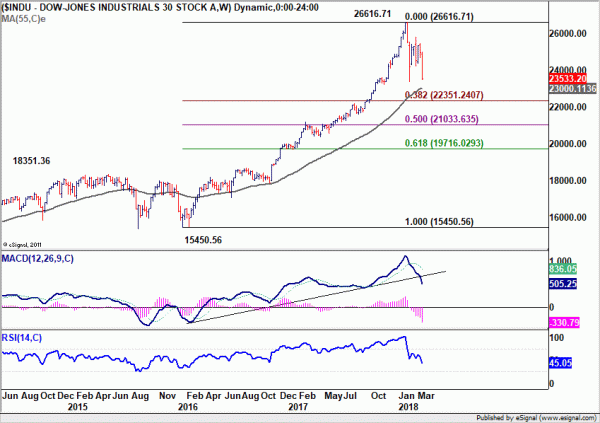 However, for now, we cannot rule out the chance that it’s a correction of a larger degree. And looking at the monthly chart, the worst case is that DOW is correcting the decade long up trend from 6469.95, March 2009 low. That is, in this case, stocks are correcting all the advancements since Barack Obama took office in January 2009. This is not our preferred case for the moment. But if it turns out to be true, DOW would head to 38.2% retracement of 6469.95 to 26616.71 at 18920.64 before bottoming. This fibonacci level is close to 18351.36 support and 55 month EMA (now at 18724.27).
However, for now, we cannot rule out the chance that it’s a correction of a larger degree. And looking at the monthly chart, the worst case is that DOW is correcting the decade long up trend from 6469.95, March 2009 low. That is, in this case, stocks are correcting all the advancements since Barack Obama took office in January 2009. This is not our preferred case for the moment. But if it turns out to be true, DOW would head to 38.2% retracement of 6469.95 to 26616.71 at 18920.64 before bottoming. This fibonacci level is close to 18351.36 support and 55 month EMA (now at 18724.27).
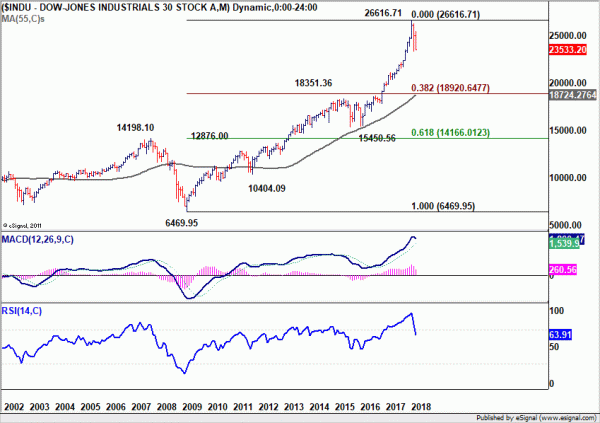 Treasury markets didn’t care much
Treasury markets didn’t care much
Reactions in the bond markets last week were relatively muted. 10 year yield attempted to take out recent resistance at 2.943 after FOMC. But then reversed the gains on Thursday. Nonetheless, TNX stayed in range between 2.80 and 2.95. While deeper fall could be seen, we’re expecting strong support from 38.2% retracement of 2.034 to 2.943 to contain downside.
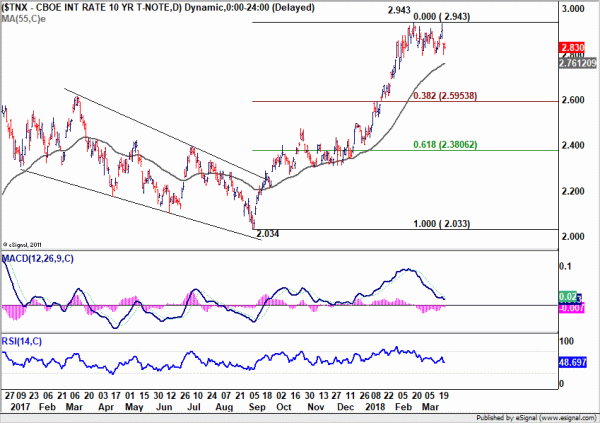 In the biggest picture, it now looks like there won’t be any momentum to push TNX through 3.036 key resistance in near term. But, it should be remembered US debt to China is at USD 1.17T as of January 2018. That’s 19% of the USD 6.26T in US debts held by foreign countries, largest among them. If dumping US debt is part of China’s retaliation measures, then this 3.036 resistance would be nothing.
In the biggest picture, it now looks like there won’t be any momentum to push TNX through 3.036 key resistance in near term. But, it should be remembered US debt to China is at USD 1.17T as of January 2018. That’s 19% of the USD 6.26T in US debts held by foreign countries, largest among them. If dumping US debt is part of China’s retaliation measures, then this 3.036 resistance would be nothing.
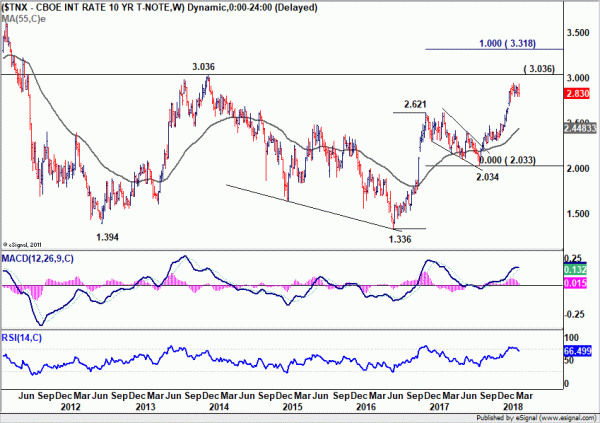 Dollar index range bound, thanks to weak Euro
Dollar index range bound, thanks to weak Euro
While Dollar was the second weakest major currency last week, next to Aussie, the dollar index didn’t perform too badly. That’s mainly because Euro was strong neither. Outlook stays bearish with 91.01 support turned resistance intact. Based on current development, the falling 55 day EMA could finally press dollar index through 88.25 low to resume the down trend from 103.82. In that case, dollar index would try to draw support from 61.8% retracement of 72.69 to 103.82 at 84.58 to form an important bottom.
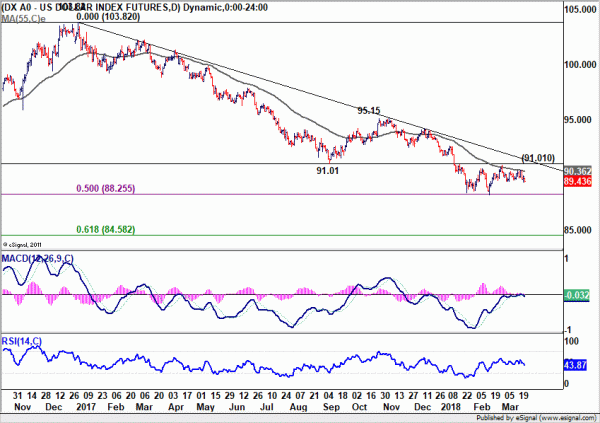 USD/JPY Weekly Outlook
USD/JPY Weekly Outlook
USD/JPY dropped to as low as 104.63 last week and the break of 105.24 support confirms resumption of decline from 114.73. Such decline is viewed as the third leg of the medium term pattern from 118.65. Initial bias remains on the downside this week for 104.20 projection level first. Sustained break there will pave the way to 98.97 (2016 low). On the upside, break of 106.63 resistance is needed to indicate short term bottoming. Otherwise, outlook will remain bearish in case of recovery.
In the bigger picture, medium term down trend from 118.65 (2016 high) is still in progress and extending. Build up in downside momentum argues that it might be extending the whole corrective pattern from 125.85 (2015 high). 100% projection of 118.65 to 108.12 from 114.73 at 104.20 will be a key level to watch as firm break there could bring downside acceleration. And in that case, 98.97 key support level (2016 low) would at least be breached. This bearish case will now be favored as long as 108.12 support turned resistance holds.
In the long term picture, the rise from 75.56 (2011 low) long term bottom to 125.85 top is viewed as an impulsive move, no change in this view. Price actions from 125.85 are seen as a corrective move which could still extend. In case of deeper fall, downside should be contained by 61.8% retracement of 75.56 to 125.85 at 94.77. Up trend from 75.56 is expected to resume at a later stage for above 135.20/147.68 resistance zone.




